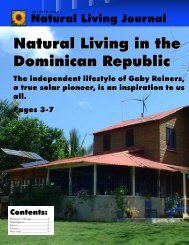Volume 3 - Program & Project Ideas (PDF - 4.5 - Natural Life Network
Volume 3 - Program & Project Ideas (PDF - 4.5 - Natural Life Network
Volume 3 - Program & Project Ideas (PDF - 4.5 - Natural Life Network
Create successful ePaper yourself
Turn your PDF publications into a flip-book with our unique Google optimized e-Paper software.
<strong>Natural</strong> Resources Canada – Community Energy Systems<br />
A.2 Community energy systems<br />
A community energy system represents the most effective approach that a community<br />
may take to manage its energy needs. The concept involves a network of energy users<br />
and providers, trading energy needs through a physical network of hot water piping.<br />
Energy users maybe residential, commercial or industrial and energy suppliers may<br />
include anyone with excess or reject thermal energy. Examples might include: industry,<br />
combined heat and power plants, solar collectors and municipal landfill sites.<br />
- Case study: Vancouver<br />
Central Heat Distribution Limited, a private sector operation in Vancouver began life in<br />
1968 and is now in a prime position to take advantage of the high-density building boom<br />
in downtown Vancouver. After 35 years of operation, the system now supplies 170<br />
buildings, of which 60 are condominiums, 75 are offices and 15 or so are institutional.<br />
Included in that list are the famous Steam Clock in Gastown, an excellent brewpub and<br />
General Motors Place.<br />
Even though this is a private undertaking there are very close ties with City Hall. Central<br />
Heat is treated much like any other utility and charged a ‘franchise’ fee is charged<br />
annually. In addition the City retains the right to undertake the street-based piping<br />
installation at a rate of ‘cost plus 20%’. This is to ensure that the roads standards are<br />
adhered to. In return, City Hall regularly consults with Central Heat regarding their citycentre<br />
planning activities to ensure compatibility of new developments with the district<br />
energy system. New businesses are also encouraged to establish in the area to take<br />
advantage of the stabilized energy prices.<br />
The locally owned and operated company provides the City planners with many benefits<br />
– the elimination of multiple stacks and the maintenance of view corridors. Architects<br />
benefit from increased flexibility of design – rooflines, etc. and building owners are quick<br />
to realize the fiscal benefit of eliminating mechanical spaces as land prices increase. The<br />
additional floor space is a major attraction.<br />
For further information contact Central Heat Distribution – John Barnes, President Tel: (604)<br />
688 9584<br />
- Case study: Copenhagen, Denmark<br />
Copenhagen operates the largest district-heating grid in Europe. In 1993, an area<br />
including 1.2 million inhabitants was supplied with district heating; 65 per cent of the<br />
buildings were connected to the district-heating grid. The target was set for 95 per cent<br />
connected to the grid by 2002. The district heating is almost exclusively produced<br />
through cogeneration of heat and power.<br />
• The city has the ability to achieve a 30 per cent reduction in CO2 emissions by<br />
the year 2005.<br />
Source: BUND for Environment and Nature Protection Germany. 1993. Vorbildliche kommunale<br />
Energieprojekte in Europa. Translation and revision by ICLEI in 1996. ICLEI case study.<br />
Draft 4/11/2005 109






